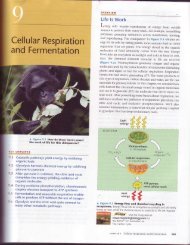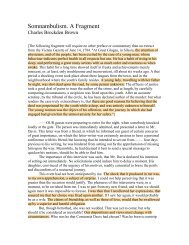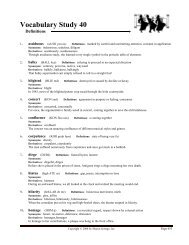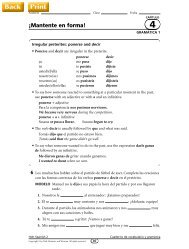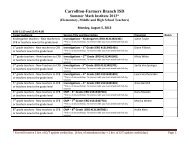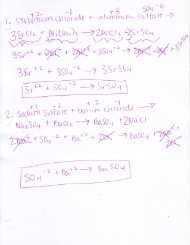Pt Two
Pt Two
Pt Two
You also want an ePaper? Increase the reach of your titles
YUMPU automatically turns print PDFs into web optimized ePapers that Google loves.
UNIT NINE: Late Baroque and Rococo STUDY GUIDE<br />
T Thomas Gainsborough. Mrs. Richard Brinsley Sheridan, 1787, oil on canvas<br />
an elegant portrait inspired by van Dyck/ a pastoral, “natural” setting/ David Hume‟s “natural man”<br />
1. “A number of British patrons… remained committed to the kind of portraiture Van Dyck had brought to<br />
England in the 1620s, which had featured more informal poses against natural vistas. Thomas Gainsborough<br />
achieved great success with this mode when he moved to Bath in 1759 to cater to the rich and fashionable<br />
people who had recently begun to go there in great numbers. A good example of this mature style is the<br />
Portrait of Mrs. Richard Brinsley Sheridan, which shows the professional singer and wife of a celebrated<br />
playwright seated informally outdoors” (Stokstad, Art History 933-4).<br />
2. With the aid of his light, Rococo palette and feathery brushwork, Gainsborough displays an ability to<br />
integrate his sitter into the landscape. “The effect is especially noticeable in the way her windblown hair<br />
matches the tree foliage overhead. The work thereby manifests one of the new values of the Enlightenment:<br />
the emphasis on nature and the natural as the sources of goodness and beauty” (934).<br />
3. “Elizabeth Linley‟s beauty and exceptional soprano voice brought her professional success in concerts and<br />
festivals in Bath and London. After marrying Sheridan in 1773 she left her career to support and participate<br />
in her husband‟s activities as politician, playwright, and orator. Sheridan‟s work was immensely popular, and<br />
his witty plays, A School for Scandal and The Rivals, are a beloved part of today‟s theatrical repertoire. Mrs.<br />
Sheridan is shown here at the age of thirty-one, a mature and elegant woman. Merged into the landscape, her<br />
gracious form bends to the curve of the trees behind her. Light plays as quickly and freely across her dress as it does across the clouds<br />
and the sky. The distinct textures of rocks, foliage, silk, and hair are unified by the strong, animated rhythms of Gainsborough‟s brush.<br />
The freely painted, impressionistic style of Mrs. Sheridan‟s costume and the windblown landscape reflect the strong romantic component<br />
in Gainsborough‟s artistic temperament. However, his primary focus remains on his sitter‟s face and on her personality. Her chin and<br />
mouth are firm, definite, and sculptural, and her heavily drawn eyebrows give her a steady, composed, and dignified expression. There is<br />
a hint of romantic melancholy in her eyes, with their slightly indirect gaze” (Anderson 152). “Thomas Gainsborough prospered greatly from<br />
the portrait trade, but both he and his patrons preferred a light and airy version of the sentimental portrait, what Joshua Reynolds in not<br />
very complimentary terms called „fancy pictures‟. Because he objected to the great height at which pictures were hung in the Royal<br />
Academy, Gainsborough quarreled with the organizers of the exhibition in 1784 and refused thereafter to participate, preferring to show<br />
his paintings at his own home, where he had control over the lighting and display. He insisted upon a close view: his conception of a<br />
picture was of something delicate and fine, not ponderous and dense” (Minor 235).<br />
U Sir Joshua Reynolds. Mrs. Sarah Siddons as the Tragic Muse, 1784, oil on canvas<br />
Sir Joshua Reynolds/ Discourses on Art/Sarah Siddons/ portrait in the grand style (or “grand manner”<br />
portraiture)<br />
1. “While the burgeoning middle classes in France and England were embracing the work of Greuze and<br />
Hogarth, their upper-class contemporaries continued to commission flattering portraits. The leading portrait<br />
painter in late-eighteenth century England was probably Sir Joshua Reynolds (1723-1792), the inaugural<br />
president of the Royal Academy (established in 1768). His Fifteen Discourses to the Royal Academy (1769-<br />
1790) set out his theories on art: Artists should follow the rules derived from studying the great masters of the<br />
past, especially those who worked in the classical tradition; art should generalize to create the universal rather<br />
than the particular; and the highest kind of art is history painting” (Stokstad, Art History 933). “Because<br />
British patrons preferred portraits of themselves to scenes of classical history, Reynolds attempted to elevate<br />
portraiture to the level of history painting by giving it a historical or mythological veneer” (933). “We now tend<br />
to prefer the fresher brush of his rival Gainsborough to Reynold‟s contrivances. A restless and indiscriminate<br />
experimenter with media and pigments, imitating the surface effects of Old Master paintings without an<br />
understanding of their methods, he saw his pictures fade, flake and crack, so that portraits „died‟ before their<br />
sitters. Even his contemporaries protested at his technical shortcomings. Yet the more we look at Reynolds,<br />
in the prodigious variety which Gainsborough rightly envied, the more we see that he indeed achieved what he<br />
defined as‟ that one great idea, which gives to painting its true dignity… of speaking to the heart.” (Langmuir<br />
316).<br />
2. Unlike Reynolds, “Gainsborough did little reading, had few intellectual interests, shunned the circle of wits that gathered around<br />
[Samuel] Johnson.” (Durant, Rousseau and Revolution 757) “Reynolds was a man; of the world, ready to make the obeisances required for<br />
social acceptance; Gainsborough was a passionate individualists who raged at the sacrifices demanded of his personality and his art as<br />
the price of success” (755). “Reynolds‟ Grand Style did not exclude the sense of play and sentiment typical of the age. Sarah Siddons was<br />
the most famous tragic actress of her time, especially renowned for her portrayal of Lady Macbeth in Shakespeare‟s play Macbeth… Yet<br />
her pose here is nonchalant- it gives an appearance of being effortless or unposed. One of the stories associated with the painting tells us<br />
that Sarah Siddons, late for her sitting, rushed into Reynolds‟ studio, threw herself on the throne, removed her bonnet, rested her head<br />
momentarily in her hand, then turned to the painter and asked, „How shall I sit?‟ „Just as you are,‟ Sir Joshua replied. Mrs. Siddons also<br />
related to another painter that the pose came from an idle moment when Reynolds was preparing some colors and she happened to turn<br />
and look at another of the artist‟s paintings hanging on the wall. He saw the expression and pose, and asked that she hold it” (Minor<br />
233).<br />
30



